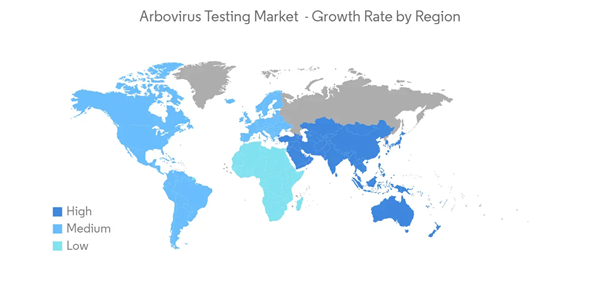Key Highlights
- The major factors accounting for the growth of the arbovirus testing market are the increasing rate of incidence and prevalence of Arbovirus throughout the world, recent advancements in technology, and emerging rapid Serology Tests that may drive the arbovirus testing market during the forecast period.
- For example, WHO has reported that the number of dengue cases reported increased over 15-fold over the last two decades, from 505,430 cases in 2000 to over 2,400,138 in 2010 and 3,312,040 in 2015. Deaths from 2000 to 2015 increased from 960 to more than 4032, which strongly supports the increase in the incidence of arboviral diseases.
- Thus, the incidence rate of Arboviral diseases drives the growth of the arbovirus testing market during the forecast period. However, the lack of in vitro facilities, lack of awareness, and limited availability of diagnostic testing procedures may restrain the studied market's growth during the forecast period.
Arbovirus Testing Market Trends
In Test Type Segment, Reverse Transcriptase Polymerase Chain Reaction (RT-PCR) Based Tests Dominates the Market and the Same is Expected Over the Forecast Period.
The RT-PCR based tests segment is expected to dominate the arbovirus testing market over the forecast period, attributing to its advantages. A key difference between ELISA (Enzyme-linked immunosorbent assay) and PCR tests is the detection limit. Typically, an ELISA-based method will have a limit of 104-106 CFU/ml, whereas a PCR method can detect in the range of 103 CFU/ml. This difference in detection limit usually means that a longer enrichment time is required for an ELISA method. Even in terms of sensitivity, the PCR technique is very sensitive and specific over ELISA. The wastes produced in the laboratories by adopting the PCR technique are less compared to ELISA. Hence, all these factors together suggest that RT-PCR based tests dominate the arbovirus testing market during the forecast period.North America Dominates the Market and the Same is Expected Over the Forecast Period.
North America is expected to dominate the overall market, throughout the forecast period, which has been attributed to the developed economy, increasing health care expenditure, and high adoption of technologically advanced products in the region. Thus, North America dominates the arbovirus testing market during the forecast period. The market in Asia-Pacific is expected to register a high CAGR due to larger population density, which facilitates the easy spread of the arboviral diseases.Arbovirus Testing Industry Overview
The arbovirus testing market is moderately competitive and consists of several major players. With the increasing consolidations of various organizations and product recalls in the healthcare sector, it is expected to generate competitive rivalry among the key players in the future. Some of the major players of the market are Agilent Technologies Inc., Thermo Fisher Scientific, NovaTec Immundiagnostica GmbH, Euroimmun AG, and Abbott Laboratories, among others.Additional Benefits:
- The market estimate (ME) sheet in Excel format
- 3 months of analyst support
This product will be delivered within 2 business days.









